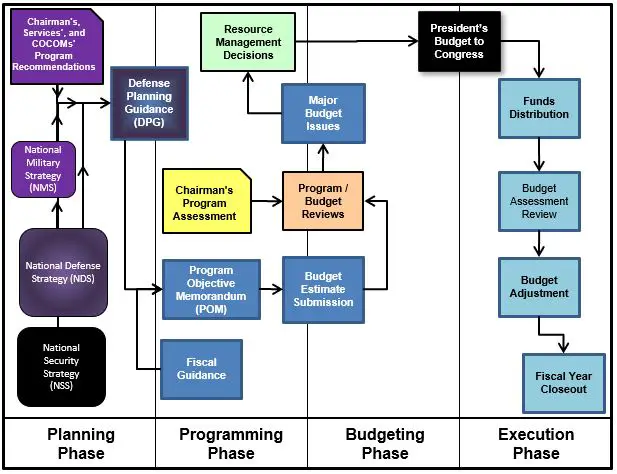 The (PPBE) process (see PPBE Map) is one of three (3) processes (Acquisition, Requirements, and Funding) that support the Defense Acquisition System. The PPBE process is focused on Financial Management and resource allocation for current and future DoD acquisition programs. The process is established by the Secretary of Defense (SecDef) who provides priorities and goals under the main guidance of DoD Directive 7045.14 “Program Planning Budget & Execution (PPBE)” Process.
The (PPBE) process (see PPBE Map) is one of three (3) processes (Acquisition, Requirements, and Funding) that support the Defense Acquisition System. The PPBE process is focused on Financial Management and resource allocation for current and future DoD acquisition programs. The process is established by the Secretary of Defense (SecDef) who provides priorities and goals under the main guidance of DoD Directive 7045.14 “Program Planning Budget & Execution (PPBE)” Process.
Purpose of the Planning, Programming, Budget, and Execution (PPBE) Process
The purpose of the PPBE process is to allocate resources within the Department of Defense (DoD).
Results of the Planning, Programming, Budget, and Execution (PPBE) Process
The primary result of the Planning, Programming, and Budgeting phases of the PPBE process is the DoD finalized defense budget request, which is included in the President’s Budget (PB) to be submitted to Congress.
Planning, Programming, Budget, and Execution (PPBE) Phases
The PPBE process consists of four (4) distinct but overlapping phases:
- Planning: The Planning Phase of the PPBE Process is the definition and examination of alternative strategies, the analysis of changing conditions and trends, threats, technology, and economic assessments in conjunction with efforts to understand both change and the long-term implications of current choices.
- Programming: The Programming phase of the PPBE process defines and analyzes alternative force structures, weapon systems, and support systems together with their multi-year resource implications and the evaluation of various tradeoff options.
- Budgeting: The Budgeting phase of the PPBE process includes formulation, justification, execution, and control of the budget. The primary purpose is to scrutinize the first one or two years of a program’s budget to ensure efficient use of resources.
- Execution: The Execution phase of the PPBE process is the real-world application of the Planning, Programming, Budgeting, and Execution process.
Planning, Programming, Budget, and Execution (PPBE) References
Presentation: Funds Management Platinum Card – July 2016
Quick Sheet: Funds Management Platinum Card – July 2016
DoD Directive: 7045.14 “Program Planning Budget & Execution (PPBE)” Process

Budget Preparation Schedule
- 1st Monday of February: President’s Budget due to Congress
- February: Future Year Defense Program (FYDP) Updated
- April: DoD Send Defense Planning Guidance (DPG) to Services
- 30 July: Services submit Program Objective Memorandum (POM) and Budget Estimate Submission (BES) to OSD, CAPE, and OMB for Review (FYDP Updated)
- October – November: OSD develops Program Decision Memorandum (PDM)
- October – December: Joint OMB-OSD review leading to Resource Management Decision (RMD)
- December: DoD Budget Request sent to Office of Management and Budget (OMB)
History of the Planning, Programming, Budgeting, and Execution (PPBE) Process
The Planning, Programming, and Budgeting System (PPBS), which was put in place by Robert McNamara as Secretary of Defense (SECDEF) in the early 1960s, gave rise to the Program Planning, Budgeting, and Execution (PPBE) method. Planning, programming, and funding were the three separate but interconnected steps that made up PPBS. For example, PPBS set up the framework and mechanisms for making decisions about the future. It also allowed people to look over past choices every year in light of the current situation, such as a growing threat, shifting economic conditions, etc.
From its start in the early 1960s to 2001, the general PPBS process stayed mostly the same. Decisions were made for each phase of Planning, Programming, and Budgeting, and paperwork and submissions for each phase were made in a straight line. In 2001, OSD changed the process so that there had to be a combined or integrated Programming/Budgeting phase. During this phase, the different Programming and Budgeting documents had to be prepared and sent in simultaneously, and decisions had to be made almost simultaneously. One reason for this change was to ensure the decision-making process for these phases was more coordinated.
Also, in May 2003, PPBS went through some bigger changes. The PPBS process was changed to the Planning, Programming, Budgeting, and Execution (PPBE) process, among other things. Adding “Execution” to the process meant clarifying that the budget power given by Congress through the appropriations acts needs to be better managed. This “execution” was supposed to include more than ensuring that the budget authority met its obligations on time. It was also supposed to include a comparison of what DoD said it would do with its funds and what it did (i.e., outcomes reached). The Government Performance Results Act (GPRA) says all big Executive Branch agencies must file an Annual Performance Report (APR). This analysis helped DoD do its job better.
Until late December 2014, the Programming and Budgeting processes were done together. However, the DEPSECDEF signed a document that “re-set” the PPBE process so that POM and BES submissions, analyses, and choices would be made separately. After the OSD looks at the five-year POM and the one-year BES, there will be some time overlap in the final decision-making processes. However, there will still be separate decisions (called Resource Management Decisions, or RMDs) that affect the programmatic and budgetary submissions.
AcqLinks and References:
- [1] Defense Acquisition Guidebook (DAG) – Chapter 1
- DoD Directive 7045.14 “Program Planning Budget & Execution (PPBE)” Process
- Funds Management Platinum Card – July 2016
- DoD Army PPBE Executive Overview
- DoD 7000.14-R Financial Management Regulation
- Presentation: Navy Budget PPBE System
- Report: Congressional Research Service PPBE Overview – 11 Dec 2020
- Report: Commission on PPBE Reform Full Report – 6 March 2024 (10M File)
Updated: 5/14/2024
Rank: G1.1
